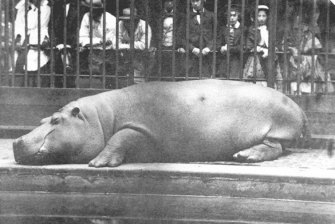History
Obaysch: A Hippopotamus in Victorian London
John Simons
Sydney University Press, $35
More than 18 months ago, George Monbiot published a column arguing we need new language if we are to truly understand the world and our impact on it.
‘‘Our assaults on life and beauty are … sanitised and disguised by the words we use. When a species is obliterated by people, we use the term ‘extinction’. It conveys no sense of our role in the extermination, and mixes up this eradication with the natural turnover of species. It’s like calling murder ‘expiration’.’’
Obaysch was a sensation when he was displayed in London Zoo.Credit:Alamy
In a very real sense John Simons’ Obaysch embodies this same impulse. A biography of Obaysch, the hippopotamus who lived at London Zoo for almost three decades in the second half of the 19th century, it seeks to recentre our understanding of Obaysch’s life.
This is not a trivial undertaking. If we are to understand animals’ lives in any meaningful way, we must, as Simons argues, learn to understand animals as more than mere things whose chief interest lies in what they represent or tell us about ourselves. Instead we must ‘‘try to give them at least a symbolic form of agency’’.
Simons, whose previous books include a study of the wombat owned by the poet Dante Gabriel Rosetti and Kangaroo, one of the few antipodean entries in Reaktion’s wonderful Animal series, is the first to acknowledge the challenges of such an approach. After all, the minds of animals are very different from our own, and unlike a human subject Obaysch had no way of leaving us a record of his thoughts or experiences.
Yet Simons’ efforts yield real results. Drawing on an understanding of the life of wild hippos and a careful reading of historical records, he presents an account that makes it clear how entirely absent Obaysch himself is from our stories about his life.
Simons’ starting point is the brief period before Obaysch was captured. Offering a wonderfully vivid portrait of the hippopotamus’ life cycle – baby hippos live mostly on their mother’s backs, need to breathe every two minutes, so ‘‘rise and fall, like hippo-shaped balloons’’, while the famous ‘‘bloodsweat’’ hippos produce is actually a natural antibiotic that protects their skin from ultraviolet radiation – Simons moves on to Obaysch’s capture and transport to London.
In some ways these passages are the most distressing in the entire book. At the time of his capture Obaysch appears to have been less than a year old, and clearly still being suckled by his mother. Simons rejects the standard account, which explains away the scar clearly visible in photos of Obaysch as the result of an accidental flesh wound.
Instead he argues it was intentionally caused by a particularly cruel kind of harpoon. Alongside this he details the fate of a host of other animals captured and transported to Europe, America and Australia in the same period, a catalogue of death and misery that makes the monstrous cruelty of the exercise inescapable.
Upon his arrival in London Obaysch was a sensation. The first hippo to be seen in England since Roman times, and possibly the last interglacial, more than 120,000 years ago, he was celebrated in newspapers and elsewhere.
Drawing upon these accounts, Simons illustrates the ways in which perceptions of Obaysch were shaped and managed by the business imperatives of the zoo and the assumptions of those who observed him.
Simons’ reading of these questions is sophisticated and alert to the complexities of the world from which they emerge. But he also asks the reader to look past and through them, at Obaysch himself, a creature who was not the gentle giant the zoo worked so hard to convince everybody he was, but a being in his own right, a creature ‘‘radically different and distant’’ from ourselves, who was forced to endure a life totally unlike the one he was equipped for.
If Simons’ fascinating and moving book has a failing, it is that we only ever grasp this otherness tangentially and intermittently. Nonetheless there is little question his account of Obaysch’s life grants this long-dead animal an agency and individual importance our accounts of animals usually lack.
And in so doing he forces us to confront the ways in which our failure to recognise this perpetuate our ongoing and increasingly ecocidal violence against the extraordinarily diverse and complex beings with which we share this planet.
Source: Read Full Article

